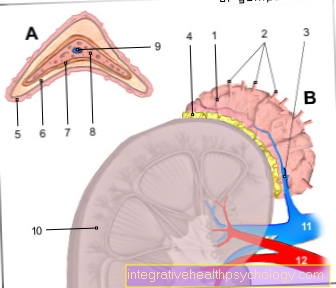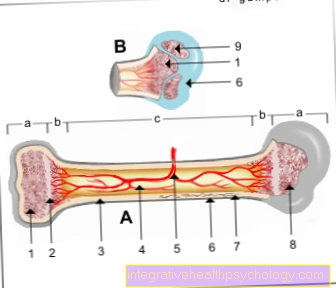Laryngeal papillomatosis
definition
Laryngeal papillomatosis is a benign tumor disease of the larynx and usually the vocal cords (larynx = Larynx). This leads to the formation of small, wart-like growths of the mucous membrane called papillomas. Laryngeal papillomatosis is triggered by the HP virus (human papillomavirus).
A distinction is made between the juvenile (childlike) and the rather rare adult (adult) Type. Laryngeal papillomatosis can be operated on and treated very well, but recurrences still occur.

root cause
The cause of the disease is the so-called HP virus (human papillomavirus). This virus is mainly known because of the cervical and anal cancers that it also triggers. Although numerous people are infected with HPV (high infection rate), a disease that manifests itself in mostly benign degeneration is very rare. The virus acts on the cells of the lining of the infected area. It causes a change there, whereupon the mucous membrane reacts by increasing cells.
HPV
HPV stands for "human papilloma virus" and describes a virus containing DNA that is very widespread. In HPV, a distinction is made between more than 100 different types, which can be divided into low-risk and high-risk viruses.
In 90% of the cases, the laryngeal papilloma is the low-risk viruses HPV type 6 and HPV type 11.
High-risk HP viruses are mainly type 16 and type 18, against which vaccination is recommended, especially in young girls. The high infection rate particularly affects children, as the immune system becomes stronger over time and a certain level of resistance develops.
Read more about this on the main page Human papillomavisrus (HPV)
transmission
The HP virus is transmitted through contact. Since it mostly occurs in the genital area, the usual mode of transmission is sexual intercourse. As a result, the virus spreads mainly in the vagina and anus, but also in the oral mucosa.
Read more about this under Sexually transmitted diseases
In children, the virus is usually found in the throat and larynx. This is often due to the mother's transmission of HPV. Since children usually do not yet have a very strong immune system, laryngeal papillomatosis occurs especially in children (juvenile type).
Concomitant symptoms
Concomitant symptoms are usually the symptoms through which the disease is noticed. This is mostly about hoarseness. The vocal cords are often affected in papillomatosis. The accumulation of the wart-like papillomas leads to an impairment of the speech function. For most of those affected, this persistent hoarseness is already a reason to see a doctor, which is why there are often no other accompanying symptoms.
However, if the tumor grows relatively quickly or is ignored for a long time, it can also lead to a change in breathing. In this case, a slight breathlessness and restlessness are often perceived, which arise either from a narrowed glottis or from infiltration of the trachea.
Another possible symptom is difficulty swallowing. This leads to a pronounced mass in the larynx.
Read also on this topic Vocal cord nodules
diagnosis
Larnyx papillomatosis usually manifests itself at the beginning with a rough voice or hoarseness, since in the majority of cases the vocal cords are affected. If the papillomatosis is more advanced, you may experience difficulty breathing or difficulty swallowing. In this case, the degeneration would have reached a size that involves large parts of the larynx and the windpipe. If the hoarseness persists without an apparent cause, a doctor should definitely be consulted. In this case, a laryngoscopy is usually done. In order to confirm the suspicion, a biopsy is usually taken, in which the mucous membrane is examined histologically.
Treatment / therapy
Various methods can be used to treat laryngeal papillomatosis.
The most common application is the microsurgical removal of papillomas under general anesthesia. It is very important that the mucous membrane is removed as superficially as possible, otherwise scarring may occur, which can lead to permanent vocal cord damage, hoarseness or shortness of breath.
Another possibility is the outpatient removal of the papillomas using a specific laser technique. In addition to these invasive interventions, patients are usually also given antivirals (Cidofovir) treated.
In addition to therapeutic measures, however, prophylaxis is particularly important. For the most common HPV types (6, 11, 16, 18) there are vaccines which are recommended by the Standing Vaccination Commission (STIKO). Due to the high risk of recurrence, patients who have already been treated are usually vaccinated.
Read more about this under General anesthesia - procedure, risks and side effects
cure
In principle, HPV infection is an incurable disease, as the viruses usually remain in the body for a lifetime if the symptoms were previously manifest. Therefore, despite a successful operation, the disease often recurs after a few weeks. In this case, the operation must be repeated. In the juvenile form, however, children only get sick from puberty in exceptional cases because their immune system has become stronger. Long-term therapy with antivirals can also reduce the recurrence rate, as they can permanently reduce the growth of the viruses.





























